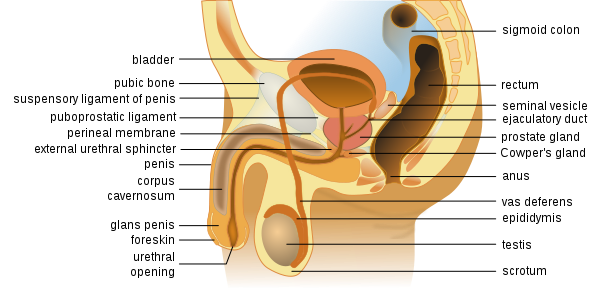
The function of the secretion of prostate gland is to_____________
A. Inhibit sperm activity
B. Attract sperms
C. Stimulate sperm activity
D. None of these
Answer
567.9k+ views
Hint: The prostate gland is a part of the male accessory gland system. It releases the fluid rich in minerals, carbohydrates, this fluid from the part of seminal fluid.
Step by step answer:Prostate gland: The prostate gland is a part of the male reproductive system. It is a male accessory gland along with seminal vesicles and bulbourethral glands. Secretions of these glands constitute the seminal fluid o, which contains enzymes, minerals, and sugar. It is rich in fructose which acts as the main nutrition source for the sperm while its movement.
-Prostate gland found in the pelvic region, below the bladder with urethra passing through it. The sperm formed in the testis passes through the ejaculatory duct, the fluid from the prostate, seminal vesicles, and bulbourethral gland mixes with spermatozoa and forms the semen.
-The function of seminal fluid: This fluid is very important for sperm activity as it provides nutrition and protection to the sperm while its journey inside the female reproductive system. Inside the vagina, the environment is not very conducive for the sperm, as it has to tackle prevalent acidic conditions along with immune cells. The seminal fluid is basic which provides a buffer against the acid, as it neutralizes it, other enzymes, minerals protect other factors allowing smooth movement of the sperm cells. Thus, fluid from the prostate gland stimulates sperm activity.

Hence option C is correct.
Additional information: The seminal fluid is basic, semen contains $10$ percent sperm \[90\] percent seminal fluid. The bulbourethral gland is also called Cowper's gland.
Note: The prostate gland is a part of the male reproductive system, made up of smooth muscles and glands which provide the force to seminal fluid for the ejaculation of the semen.
Step by step answer:Prostate gland: The prostate gland is a part of the male reproductive system. It is a male accessory gland along with seminal vesicles and bulbourethral glands. Secretions of these glands constitute the seminal fluid o, which contains enzymes, minerals, and sugar. It is rich in fructose which acts as the main nutrition source for the sperm while its movement.
-Prostate gland found in the pelvic region, below the bladder with urethra passing through it. The sperm formed in the testis passes through the ejaculatory duct, the fluid from the prostate, seminal vesicles, and bulbourethral gland mixes with spermatozoa and forms the semen.
-The function of seminal fluid: This fluid is very important for sperm activity as it provides nutrition and protection to the sperm while its journey inside the female reproductive system. Inside the vagina, the environment is not very conducive for the sperm, as it has to tackle prevalent acidic conditions along with immune cells. The seminal fluid is basic which provides a buffer against the acid, as it neutralizes it, other enzymes, minerals protect other factors allowing smooth movement of the sperm cells. Thus, fluid from the prostate gland stimulates sperm activity.

Hence option C is correct.
Additional information: The seminal fluid is basic, semen contains $10$ percent sperm \[90\] percent seminal fluid. The bulbourethral gland is also called Cowper's gland.
Note: The prostate gland is a part of the male reproductive system, made up of smooth muscles and glands which provide the force to seminal fluid for the ejaculation of the semen.
Recently Updated Pages
Master Class 12 Business Studies: Engaging Questions & Answers for Success

Master Class 12 Economics: Engaging Questions & Answers for Success

Master Class 12 English: Engaging Questions & Answers for Success

Master Class 12 Maths: Engaging Questions & Answers for Success

Master Class 12 Social Science: Engaging Questions & Answers for Success

Master Class 12 Chemistry: Engaging Questions & Answers for Success

Trending doubts
What are the major means of transport Explain each class 12 social science CBSE

Which are the Top 10 Largest Countries of the World?

Draw a labelled sketch of the human eye class 12 physics CBSE

Explain sex determination in humans with line diag class 12 biology CBSE

The pH of the pancreatic juice is A 64 B 86 C 120 D class 12 biology CBSE

Give 10 examples of unisexual and bisexual flowers




